RBSE Class 12 Maths Important Questions Chapter 1 Relations and Functions
Rajasthan Board RBSE Class 12 Maths Important Questions Chapter 1 Relations and Functions Important Questions and Answers.
Rajasthan Board RBSE Solutions for Class 12 Maths in Hindi Medium & English Medium are part of RBSE Solutions for Class 12. Students can also read RBSE Class 12 Maths Important Questions for exam preparation. Students can also go through RBSE Class 12 Maths Notes to understand and remember the concepts easily.
RBSE Class 12 Maths Chapter 1 Important Questions Relations and Functions
Question 1.
Let N be the set of natural numbers and R be relation on N × N defined by (a, b) R (c, d) if ad = be for all a, b,c,d ∈ N. Show that R is an equivalence relation.
Answer:
Given a relation R in N × N, such that (a, b) R (c, d) ⇔ ad = be for all (a, b), (c, d) ∈ N × N.
(i) Reflexive: For (a, b) R (a, b)
⇒ ab = ba, which is true.
So, R is reflexive.
(ii) Symmetric : For (a, b) R (c, d)
⇒ ad = be
⇒ bc = ad
⇒ cb = da
⇒ (c, d) R (a, b) is true.
So, R is symmetric.
(iii) Transitive : For (a, b) R (c, d) and (c, d) R (e,f)
⇒ ad = bc and cf= de .
⇒ \(\frac{a}{b}=\frac{c}{d}\) and \(\frac{c}{d}=\frac{e}{f}\)
⇒ \(\frac{a}{b}=\frac{e}{f}\)
⇒ af = be
So, (a, b) R (e,f) is true.
∴ R is transitive.
Thus, R is reflexive, symmetric and transitive, so R is an equivalence relation.
Hence Proved

Question 2.
Check whether the relation R in the set N of natural numbers given by R = {(a, b): a is divisor of b} is reflexive, symmetric or transitive. Also determine whether R is an equivalence relation. (CBSE 2020)
Answer:
(i) Reflexive: Let n be a natural number.
We know that n divides n, which implies nRn.
So, every natural number is related to itself in relation R.
So, relation R is reflexive.
(ii) Transitive : Let a, b, c be three natural numbers, and let aRb, bRc, aRb implies a divides b and bRc implies b divides c, which combinedly implies that a divides c i.e. aRc.
So, relation R is transitive.
(iii) Symmetric: Let a, b be two natural numbers and let aRb. aRb implies that a divides b but it can't be assured that b necessarily divides a.
Example. 2R4 implies that 2 divides 4 but 4 does not divide 2.
So, relation R is not symmetric.
Since R is reflexive and transitive but not symmetric, thus, R is not an equivalence relation.
Question 3.
Show that the relation R in the set A = {1, 2, 3, 4, 5, 6} given by R = {(a, b): |a - b| is even} is an equivalence relation.
Answer:
Given, A = {1, 2, 3, 4, 5, 6} and R = {(a, b): |a - b| is even}
(i) Reflexive: Let a ∈ A
then |a - b| = 0 is an even number.
∴ (a, a) ∈ R, ∀ a ∈ A
∴ R is reflexive.
(ii) Symmetric : Let a, b ∈ A ∀ (a, b) ∈ R
⇒ |a - b| is even
⇒ |- (b - a)| is even
⇒ |b - a| is even
⇒ |b - a| ∈ R
⇒ (b, a) ∈ R*
∴ R is symmetric.
(iii) Transitive : Let a, b, c ∈ A ∀ (a, b) ∈ R and (b, c) ∈ R
We have |a - b| is even and |b - c| is even
⇒ a-b is even and b-c is even
⇒ (a-b) + (b - c) is even
⇒ (a -c) is even
⇒ | a - c | is even
⇒ (a, c) ∈ R
R is transitive
Thus, R is an equivalence relation. Hence proved.
Question 4.
Check if the realtion R on the set A = {1,2,3,4, 5,6} defined as R = {(x, y): y is divisible by x} is
(i) symmetric
(ii) transitive.
Answer:
Given, A = {1, 2, 3, 4, 5, 6}
R = {(x, y): y is divisible by x]
(i) Reflexive: We know that any number (x) is divisible by itself.
(x, x) ∈ R
R is reflexive.
(ii) Symmetric: Now, (2, 4) ∈ R [as 4 is divisible by 2]
But (4,2) gR [as 2 is not divisible by 4]
R is not symmetric.
(iii) Transitive: Let (x, y), (y, z) ∈ R. Then, y is divisible by x and z is divisible by y.
∴ z is divisible by x.
⇒ (x, y) ∈ R
∴ R is transitive
Thus, R is reflexive and transitive but not symmetric.

Question 5.
Check if the relation R in the set R of real numbers defined as R = {(a, b) :a<b} is (i) symmetric (ii) transitive.
Answer:
Given, R = {(a, b): a < b}
(i) Symmetric:
If (a, b) ∈ R is such that a < b then,
(b, a) ∈ R is not possible.
Example : (2,3) ∈ R, but (3, 2) ∈ R
∴ Relation R is not symmetric.
(ii) Transitive:
If (a, b) ∈ R and (b, c) ∈ R such that a < b and b < c, then clearly, a < c i.e. (a, c) ∈ R
Relation R is transitive.
Question 6.
Show the function f: R → R defined by f(x) = \(\frac{x}{x^2+1}\) as injection, surjection or bijection.
Answer:
We have, a function f:R → R defined by f(x) = \(\frac{x}{x^2+1}\) ∀ x ∈ R
(i) Injection test: Let x1, x2 ∈ R such that
⇒ x1(x22 + 1) = x2(x12 + 1)
⇒ x1x22 + x1 = x2x12 + x2
⇒ x1x2(x2 - x1) = (x2 - x1)
⇒ (x2 - x1)(x1x2 - 1) = 0
⇒ x2 = x1 or x1x2 = 1
⇒ x1 = x2 or x1 = \(\frac{1}{x_2}\)
Here, f is not an injection.
∴ f is not one-one.
(ii) Surjection test : Let y ∈ R (condomain) be any arbitrary element.
Consider, y = f(x)
∴ y = \(\frac{x}{x^2+1}\) ⇒ x2y + y = x
⇒ x2y - x + y = 0
⇒ x = \(\frac{1 \pm \sqrt{1-4 y^2}}{2 y}\), which does not exist for 1 - 4y2 < 0, i.e. for y > \(\frac{1}{2}\) and y < -\(\frac{1}{2}\)
In particular for y = 1 ∈ R (co-domain), there does not exist any x ∈ R (domain) such that f(x) = y.
∴ f is not surjection.
Thus, f is neither injection nor surjection.
Question 7.
Show that the function f: R - {3} → R - {1} given by f(x) = \(\frac{x-2}{x-3}\) is a bijection.
Answer:
Given, A = R - {3} and B = R - {1}
(i) One-one:
We have, f(x) = \(\frac{x-2}{x-3}\)
Calculate f(x1):
⇒ f(x1) = \(\frac{x_1-2}{x_1-3}\)
Calculate f(x2):
f(x1) = \(\frac{x_2-2}{x_2-3}\)
Now, f(x1) = f(x1)
⇒ \(\frac{x_1-2}{x_1-3}=\frac{x_2-2}{x_2-3}\)
⇒ (x1 - 2) (x2 - 3) = (x2 - 2)(x1 - 3)
⇒ x1x2 - 3x1 - 2x2 + 6 = x1x2 - 3x2 - 2x1 + 6
⇒ -x1 = - x2 ⇒ x1 = x2
∴ f is an one-one function.
(ii) Onto:
Let y ∈ B = R - {1}
Then, y ≠ 1
Thus, function f is onto if there exists x ∈ A such that f(x) = y.
Now, f(x) = y .
⇒ \(\frac{x-2}{x-3}\) = y ⇒ x - 2 = xy - 3y
⇒ x - 2 = xy - 3y ⇒ x(1 - y) = -3y + 2
⇒ x = \(\frac{2-3 y}{1-y}\) ∈ A [Here y ≠ 1]
So, for any y ∈ B, there exists \(\frac{2-3 y}{1-y}\) ∈ A such that
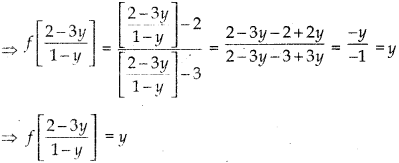
⇒ f is onto.
Since, f is one-one and onto, thus the given function is bijective.

Question 8.
If f: R → R be the function defined by f(x) = 4x3 + 7, then show that f is a bisection.
Answer:
The given function is f:R → R such that f(x) = 4x3 + 7
To show f is bijective, we have to show that/is one-one and into.
(i) One-one function: Let x1 x2∈ R such that
f(x1) = f(x2).
⇒ 4x13 + 7 = 4x23 + 7 ⇒ 4x13 = 4x23 ⇒ x13 - x23 = 0
⇒ (x1 - x2)(x12 + x1x2 + x22) = 0
[∵ a3 - b3 = (a - b)(a2 + ab + b2)]
⇒ (x1 - x2)(x12 + x1x2 + \(\frac{4}{4}\)x22) = 0
⇒ (x1 - x2)(x12 + x1x2 + \(\frac{1}{4}\)x22 + \(\frac{3}{4}\)x22) = 0
⇒ (x1 - x2)[(x1 + \(\frac{x_2}{2}\))2 + \(\frac{3}{4}\)x22] = 0
⇒ Either x1 - x2 = 0 .............(i)
or (x1 + \(\frac{x_2}{2}\))2 + \(\frac{3}{4}\)x22 = 0 ..............(ii)
But eq. (ii) gives complex roots as x1 x2 ∈ R .
x1 - x2 = 0 ⇒ x1 = x2
So, f(x1) = f(x2) ⇒ x1 = x2, ∀ x1 x2 ∈ R
Thus, f(x) is a one-one function.
(ii) Onto function : Let y ∈ R (codomain) be any arbitrary number.
Then, f(x) = y ⇒ 4x3 + 7 = y ⇒ 4x3 = y - 7
⇒ x3 = \(\frac{y-7}{4}\) ⇒ x =\( \left(\frac{y-7}{4}\right)^{1 / 3}\)
which is a real number. [∵ y ∈ R]
Thus, for every y ∈ R (codomain), there exists
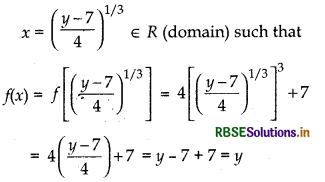
⇒ f(x) is an onto function.
Since, f(x) is both one-one and onto, so it is a bijective.
Question 9.
Given A = {2, 3,4}, B = {2, 5, 6, 7}. Construct an example of each of the following:
(i) An injective map from A to B
(ii) A mapping from A to B which is not injective
(iii) A mapping from A to B.
Answer:
(i) An injective (i.e. one-one) mapping A to B may be defined as f = (2,5), (3, 7), (4, 6)
(ii) A mapping from A to B which is not injective may be defined as g = (2,2), (3, 5), (4, 2). It is many-one.
(iii) A mapping from B to A may be defined as
h = (2,2), (5, 3), (6, 4), (7,4).
Question 10.
Show that the function f: (- ∞, 0) → (-1, 0) defined by f(x) = \(\frac{x}{1+|x|}\), x ∈ (-∞, 0) is one-one and onto
Answer:
Given, f(x) = \(\frac{x}{1+|x|}\)
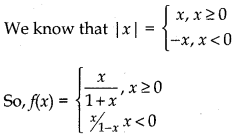
(i) One-one: For x ≥ 0
f(x1) = \(\frac{x_1}{1+x_1}\) and f(x2) = \(\frac{x_2}{1+x_2}\)
Putting f(x1) = f(x2)
\(\frac{x_1}{1+x_1}=\frac{x_2}{1+x_2}\) ⇒ x1(1 + x2) = x2(1 + x1)
⇒ x1 + x1x2 = x2 + x2x1 ⇒ x1 = x2
For x < 0
f(x1) = \(\frac{x_1}{1-x_1}\) and f(x2) = \(\frac{x_2}{1-x_2}\)
Putting f(x1) = f(x2)
\(\frac{x_1}{1-x_1}=\frac{x_2}{1-x_2}\) ⇒ x1(1 - x2) = x2(1 - x1)
⇒ x1 - x1x2 = x2 - x2x1 ⇒ x1 = x2
Here, if f(x1) = f(x2), then x1 = x2
So, f is one-one
(ii) Onto Function : Let y ∈ R (codomain) be any arbitrary element, such that - 1 < y < 1.
When y is positive,
then, f(x) = y ⇒ \(\frac{x}{1+x}\) = y
⇒ x = y + xy ⇒ x(1 - y) = y
⇒ x = \(\frac{y}{1-y}\)
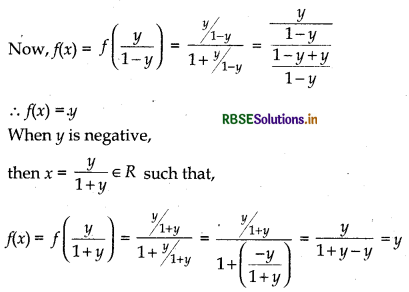
Thus, f is onto.
Question 11.
Show that the function f: N → N defined by f(x) = x2 + x + 1 is one-one but not onto. Find the inverse of f: N S, where S is range off.
Answer:
We have, f(x) = x2 + x + 1
Now , f(x1) = x12 + x1 + 1
And f(x2) = x22 + x2 + 1
Now, f(x1) = f(x2) .
x12 + x1 + 1 = x22 + x2 + 1
⇒ x12 - x22 + x1 - x2 = 0
⇒ (x1 - x2) (x1 + x2) + (x1 - x2) = 0,
[Since, a2 - b2 = (a + b) (a - b)]
(x1 - x2) (x1 + x2 + 1) = 0
Since, x1 + x2 + 1 ≠ 0 for any x ∈ N
x1 - x2 = 0 ⇒ x1 = x2
So, f is one-one function.
Clearly, f(x) = x2 + x + 1 > 3 for all x ∈ N
So, f(x) does not assume values 1 and 2.
∴ f is not an onto function.
Now, if S is the range off, then f: N → S is one-one, onto and hence invertible.
⇒ fof-1(x) = x, ∀ x ∈ S
⇒ f(f-1(x)) = x, ∀ x ∈ S
⇒ (f-1(x))2 + (f-1(x)) + 1 = x, ∀ x e S
⇒ (f-1(x))2 + f-1 (x) + 1 - x = 0,
which is a quadratic equation in f-1(x).
∴ f-1(x) = \(\frac{1 \pm \sqrt{1-4(1-x)}}{2}=\frac{-1 \pm \sqrt{4 x-3}}{2}\)
But f-1(x) ∈ N
Thus, f-1(x) = \(\frac{-1+\sqrt{4 x-3}}{2}\)

Question 12.
Let A = R - [2] and B = R - [1] If f:A → B is a function defined by f(x) = \(\frac{x-1}{x-2}\) show that f is one-one and onto. Find f.
Answer:
Given, A = R - {2} and B = R - {1}
f: A → B id defined as f(x) = \(\frac{x-1}{x-2}\)
(i) One-one : Let x, y e A such that f(x) = f(y)
⇒ \(\frac{x-1}{x-2}=\frac{y-1}{y-2}\) ⇒ (x -1) (y - 2) = (x - 2) (y -1)
⇒ xy - 2x - y + 2 = xy - x - 2y + 2
⇒ -2x - y = -x - 2y
⇒ 2x - x = 2y - y
⇒ x = y
So, f is one-one function.
(ii) Onto : Let y ∈ B = R - {1}. Then y ≠ 1.
The function f is onto if there exists x ∈ A such that f(x) = y

Therefore, f is onto.
Hence, function f is one-one and onto.
From equation (i), we get f-1(y) = \(\frac{1-2 y}{1-y}\)
⇒ f-1 (x) = \(\frac{1-2 x}{1-x}\), which is the inverse of f(x)
Question 13.
Let f: R - {\(\frac{4}{3}\)} → R be a function defined as f(x) = \(\frac{4 x}{3 x+4}\). Show that f:R - {\(-\frac{4}{3}\)} → Range (f) is one-one and onto. Hence, find f-1.
Answer:
It is given that f: R - {-\(\frac{4}{3}\)} → R be a function defined as f(x) = \(\frac{4 x}{3 x+4}\)
Let y be ab arbitrary element of range f.
Then, there exist x ∈ R - {-\(\frac{4}{3}\)} such that y = f(x)
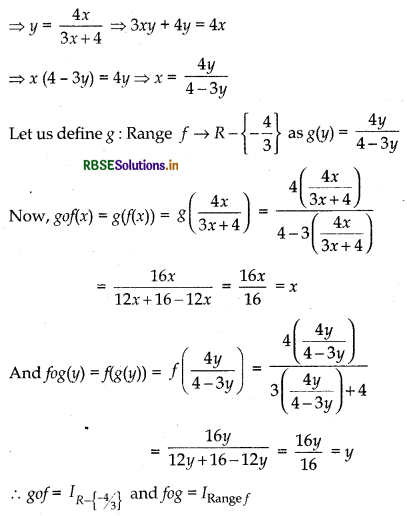
Thus, g is the inverse of f i.e, f-1 = g
Hence, the inverse of f is the map g: Range f → R - {-\(\frac{4}{3}\)}, which is given by g(y) = \(\frac{4y}{4-3y}\)
Question 14.
Let f: N → N be a function defined as f(x) = 9x2 + 6x - 5. Show that f: N → S, where S is the range off, is invertible. Find the inverse of f and hence find f-1(43) and f-1(163).
Answer:
We have a mapping f: N → N given by f(x) = 9x2 + 6x - 5
(i) One-one function : Let x1 x2 e N, such that
f(x1) = f(x2)
Then, 9x2 + 6xx - 5 = 9x2 + 6x2 -5
⇒ 9x12 + 6x2 = 9x2 + 6x2
⇒ 9(x1 -x2) + 6(x1 - x2) =0
⇒ 3(x1 - x2) (x1 + x2) + 2(x1 - x2) = 0 [divide by 3]
⇒ (x1 - x2) (3x1 + 3x2 + 2) = 0
Either x1 - x2 = 0 or 3x1 + 3x2 + 2 = 0
But 3x1 + 3x2 + 2 ≠ 0 [∵ x1, x2 ∈ N]
∴ x1 - x2 = 0
⇒ x1 = x2
So, f is one-one function.
(ii) Onto function : Obviously, f: N → S is an onto function, because S is the range of f
Thus, f: N → S is one-one and onto function.
⇒ f is invertible function, so its inverse exists.
Let f(x) = y, then y = 9x2 + 6x - 5
⇒ y = (3x)2 + 2.3x.1 + 1 - 6 ⇒ y = (3x +1)2 - 6
⇒ (3x + 1)2 = y + 6 ⇒ 3x + 1 = \(\sqrt{y+6}\)
[taking positive square root as x ∈ N]

Question 15.
Consider a bijective function f: R+ → (7, ∞) given by f(x) = 16x2 + 24x + 7, where R+ is the set of all positive real numbers. Find the inverse function off.
Answer:
The function is given by f(x) = 16x2 + 24x + 7
Let y = f(x)
⇒ y = 16x2 + 24x + 7
⇒ y = 16x2 + 24x + 7 + 2 - 2
⇒ y = 16x2 + 24x + 9 - 2
⇒ y = (4x + 3)2 - 2
⇒ (4x + 3)2 = y + 2
⇒ 4x + 3 = \(\sqrt{y+2}\)
x = \(\frac{\sqrt{(y+2)}-3}{4}\)
Now, y = f(x)
Thus, f-1 = x = \(\frac{\sqrt{(y+2)}-3}{4}\)
Question 16.
If S is the set of all rational numbers except 1 and * be defined onSbya*b = a + b-ab for all a, b ∈ S. Prove that:
(i) * is a binary operation on S.
(ii) * is commutative as well as associative
Answer:
(i) We know that, addition of two rational numbers is a rational number. Also, multiplication of two rational numbers is also a rationaF number.
Here, a and b are rational numbers other than 1. So, a + b - ab is also a rational number [Since, difference of two rational numbers is a rational number]. So * is a binary operation on set S.
(ii) Commutative:
a* b = a + b-ab-b + a-ba
⇒ a * b = b * a
Hence, * is commutative.
Associative: (a* b)* c = (a + b - ab)* c
= a + b - ab + c - (a + b - ab)c
=a + b + c - ab - bc - ac + abc ...(i)
and a* (b * c) = a* (b + c - bc)
= a +b + c - bc - a (b + c - bc)
= a + b + c - ab - be - ac + abc ...(ii)
From (i) and (ii), we have (a* b)* c = a* (a* c)
Hence, * is associative.
Question 17.
Consider the binary operation * on the set {1, 2, 3, 4, 5} defined by a * b = min (a, b). Write operation table of operation *.
Answer:
Given, binary operation is a * b = min {a, b} defined on the set {1, 2, 3, 4, 5}.
The operation table for Operation * is given as follows.
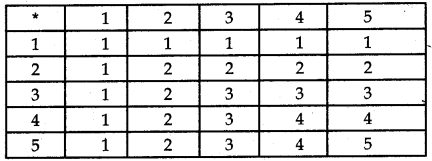
[∵ 1 * 1 = min {1,1} = 1, 1 * 2 = min {1,2} = 1
5*4 = min (5, 4} = 4,
5*4 = min {5, 5} = 5

Question 18.
If the binary operation * on the set of integers Z, is defined by a * b = a + 3b2, then find the value of 8 * 3.
Answer:
Given, a * b = a + 3b2, ∀ a, b ∈ Z
On putting a = 8,b = 3 then
8 * 3 = 8 + 3. 32 = 8 + 27 = 35
Question 19.
Let * is a binary operation on N given by a * b = LCM (a, b) for all a,b ∈ N. Find 5 * 7.
Answer:
Given a * b = LCM (a, b), ∀ a,b ∈ N
5 * 7 = LCM (5, 7) = 35
Question 20.
Let * is a binary operation on the set of all non¬zero real numbers, given by a* b = ab/5 for all a, b ∈ R - {0}. Find the value of x, given that 2 * (x * 5) = 10.
Answer:
Given, a* b = \(\frac{ab}{5}\), ∀ a, b ∈ R - {0} ...(i)
Also, given, 2* (x* 5) = 10
⇒ 2*\(\left[\frac{x \times 5}{5}\right]\) = 10
⇒ 2* x = 10 ⇒ \(\frac{2x}{5}\) = 10
⇒ x = 25
Multiple Choice Questions
Question 1.
Let R be a reflexive relation of a finite set A having n elements and let there be m ordered pairs in R. Then
(a) m ≥ n
(b) m ≤ n
(c) m = n
(d) None of these
Answer:
(a) m ≥ n
Question 2.
Let R be a relation in N defined by R = {(1 + x, 1 + x2) /x ≤ 5, x ∈ N} which of the following is false?
(a) R = {(2, 2), (3, 5), (4, 10), (5, 17), (6, 25)}
(b) Domain of R = {2,3,4, 5, 6}
(c) Range of R = (2,3,4,5, 6}
(d) (b) and (c) are true
Answer:
(a) R = {(2, 2), (3, 5), (4, 10), (5, 17), (6, 25)}
Question 3.
The relation R on numbers has the following properties:
(i) a < a ∀ a ∈ R (Reflexivity)
(ii) If a < b and b < a then a = b ∀ a,b ∈ R (Antisymmetry)
(iii) If a < b and b < c then a < c ∀ a, b ∈ R (Transitivity) Which of the above properties the relation c on p(A) has?
(a) (i) and (ii)
(b) (i) and (iii)
(c) (ii) and (iii)
(d) (i), (ii) and (iii)
Answer:
(d) (i), (ii) and (iii)

Question 4.
A relation R is defined in the set of integers I as follows (x, y) ∈ R if x2 + y2 = 9 which of the following is false?
(a) R = {(0, 3), (0, -3), (3, 0), (-3, 0)}
(b) Domain of R = {- 3, 0, 3}
(c) Range of R = {- 3, 0, 3}
(d) None of the above
Answer:
(d) None of the above
Question 5.
Let R be the real line consider the following subsets of the plane R × R S = {(x,y)/y = x + 1 and 0 < x < 2},. T = {(x, y)/x - y is an integer} Which one of the following is true?
(a) T is an equivalence relation on R but S is not
(b) Neither S nor T is an equivalence relation on R
(c) Both S and T are equivalence relation on R
(d) S is an equivalence relation on R but T is not
Answer:
(a) T is an equivalence relation on R but S is not
Question 6.
If A is the set of even natural numbers less than 8 and B is the set of prime numbers less than 7, then the number of relations from A to Bis:
(a) 29
(b) 92
(c) 32
(d) 29 - 1
Answer:
(a) 29
Question 7.
Let W denotes the words in the English dictionary define by the relation R by R = {(x, y) ∈ W × W the word x and y have at least one letter in common}. Then R is:
(a) Not reflexive, symmetric and transitive
(b) Reflexive, symmetric and not transitive
(c) Reflexive, symmetric and transitive
(d) Reflexive, not symmetric and transitive
Answer:
(b) Reflexive, symmetric and not transitive
Question 8.
Given the relation on R = {(a, b), (b, c)} in the set A = {a, b, c}. Then the minimum numbers of ordered pairs which added to R make it an equivalence relation is:
(a) 5
(b) 6
(c) 7
(d) 8
Answer:
(c) 7
Question 9.
Let R be the relation over the set N × N and is defined by (a, b) R (c, d) ⇒ a + d = b + c. Then R is :
(a) Reflexive only
(b) Symmetric only
(c) Transitive only
(d) An equivalence relation
Answer:
(d) An equivalence relation
Question 10.
Which one of the following relations on R is an equivalence relation?
(a) aR1b ⇔ |a| = |b|
(b) aR2b ⇔ a ≥ b
(c) aR3b ⇔ a divides b
(d) aR4b ⇔ a < b
Answer:
(a) aR1b ⇔ |a| = |b|
Question 11.
R = {(x, y) / x, y ∈ I, x2 + y2 ≤ 4} is a relation in I then domain of R is :
(a) {0,1,2}
(b) {- 2, - 1, 0}
(c) {- 2, -1, 0,1, 2}
(d) {- 2, -1}
Answer:
(c) {- 2, -1, 0,1, 2}

Question 12.
An integer m is said to be related to another integer n if m is a multiple of n then the relation is :
(a) Reflexive and symmetric
(b) Reflexive and transitive
(c) Symmetric and transitive
(d) Equivalence relation
Answer:
(b) Reflexive and transitive
Question 13.
Which of the following defined on Z is not an equivalence relation:
(a) (x, y) ∈ S ⇔ x ≥ y
(b) (x, y) ∈ S ⇔ x = y
(c) (x, y) ∈ S ⇔ x - y is a multiple of 3
(d) (x, y) ∈ S is |x - y| is even
Answer:
(a) (x, y) ∈ S ⇔ x ≥ y
Question 14.
If S is defined on R by (x, y) ∈ S ⇔ xy ≥ 0, then S is
(a) an equivalence relation
(b) reflexive only
(c) symmetric only
(d) transitive only
Answer:
(a) an equivalence relation
Question 15.
If A = {1,2,3}, then the number of equivalence relation containing (1, 2) is :
(a) 1
(b) 2
(c) 3
(d) 8
Answer:
(b) 2
Fill in the Blanks
Question 1.
A relation JR in a set A is called an ____________ relation, if no element of A is related to any element of A.
Answer:
empty
Question 2.
Both the empty relation and the universal relation are sometimes called ____________ relations.
Answer:
trivial
Question 3.
To study ____________ relation, we first consider three types of relations, namely reflexive, symmetric and transitive.
Answer:
equivalence
Question 4.
If f: R → R be given by f(x) = (3 - x3)1/3, then fof (x) = ____________
Answer:
x
Question 5.
A relation in a set A is called ____________ relation, if each element of A is related to itself.
Answer:
reflexive

True/False
Question 1.
A relation R in a set A is said to be an equivalence relation if R is reflexive and transitive.
Answer:
False
Question 2.
Transitive relation R in X is a relation satisfying (a, b) ∈ R implies that (a, c) ∈ R.
Answer:
True
Question 3.
A function f: X → Y is bijective, if/is both one-one and onto.
Answer:
True
Question 4.
A function f: X → Y is invertible if and only if f is surjective.
Answer:
False
Question 5.
A binary operation * on a set A is a function * from A ∩ A to A.
Answer:
False

- RBSE Class 12 Maths Notes Chapter 13 Probability
- RBSE Class 12 Maths Notes Chapter 12 Linear Programming
- RBSE Class 12 Maths Notes Chapter 11 Three Dimensional Geometry
- RBSE Class 12 Maths Notes Chapter 10 Vector Algebra
- RBSE Class 12 Maths Notes Chapter 9 Differential Equations
- RBSE Class 12 Maths Notes Chapter 8 Application of Integrals
- RBSE Class 12 Maths Notes Chapter 7 Integrals
- RBSE Class 12 Maths Notes Chapter 6 Application of Derivatives
- RBSE Class 12 Maths Notes Chapter 5 Continuity and Differentiability
- RBSE Class 12 Maths Notes Chapter 4 Determinants
- RBSE Class 12 Maths Notes Chapter 3 Matrices